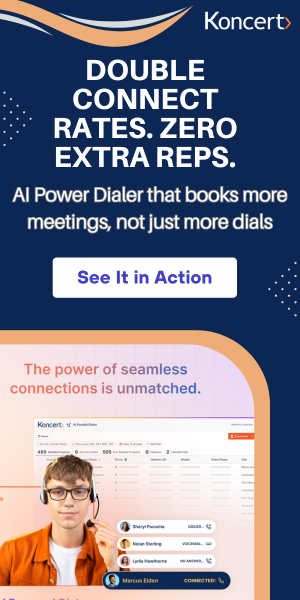4 min read
Progressive Dialer: What It Is, How It Works & Key Benefits
By: Koncert Marketing on Aug 11, 2025 5:00:11 PM
What is a Progressive Dialer?
A progressive dialer is a type of automated outbound calling system designed for call centers and sales teams. Unlike a predictive dialer that dials multiple numbers at once, a progressive dialer dials one number at a time only after an agent becomes available. This ensures that every connected call is immediately routed to a live agent, eliminating the risk of a "silent call" or high call abandonment rates.
The dialer automatically feeds the agent a contact from a pre-defined list, dials the number, and then presents the agent with the prospect's information (from the CRM) on their screen just as the call begins. This approach balances efficiency with a more personalized, human-centric approach.
How a Progressive Dialer Works
-
Agent Availability Signal: The process begins when an agent becomes available, often by finishing a previous call and setting their status to "ready."
-
Contact Selection: The progressive dialer automatically selects the next contact from a predefined campaign list in the CRM. The contact selection can be based on a queue, priority rules, or other criteria.
-
CRM Data Push: The dialer immediately pushes the prospect's information—such as their name, company, title, and call history—to the agent's screen.
-
Automatic Dialing: The dialer automatically places the call to the prospect's number. The agent does not have to manually dial.
-
Connection and Conversation: Once the call is connected, the agent immediately begins the conversation with all the relevant context displayed on their screen. The agent's talk time is maximized, as they don't waste time on dialing or listening to rings.
-
Post-Call Wrap-up: After the call, the agent typically has a short "wrap-up" period to log notes, update the CRM, and prepare for the next call. The progressive dialer will not place the next call until this wrap-up time is complete and the agent is ready.
Benefits of Progressive Dialers
-
Zero Abandoned Calls: This is the primary and most significant benefit. Since the dialer only places a call when an agent is ready, there is virtually no chance of a "silent call" where a prospect answers and no agent is there to speak to them. This is crucial for maintaining a professional brand image and avoiding legal penalties associated with high abandonment rates.
-
Enhanced Customer Experience: Prospects are never met with silence, leading to a better initial impression. The agent also has immediate access to the prospect's details, allowing for a more personalized and informed conversation right from the start.
-
Improved Compliance: Progressive dialers are highly compliant with telemarketing regulations, such as the Federal Communications Commission's (FCC) rules, because they do not have the high call abandonment rates often associated with predictive dialers. This reduces legal risk and potential fines.
-
Increased Agent Efficiency: While not as aggressive as a predictive dialer, a progressive dialer still significantly boosts agent efficiency by eliminating the manual process of dialing and waiting for calls to connect, ring, or go to voicemail.
-
Better Data Accuracy: The pre-call preview of prospect information gives agents an opportunity to review and verify details, leading to more accurate CRM data. Post-call wrap-up time also ensures that call dispositions and notes are properly logged.
-
Ideal for Complex Sales: Because agents have time to review prospect information before the call, progressive dialers are well-suited for more complex B2B sales, high-value accounts, and situations where personalization is critical.
Best Practices for Using Progressive Dialers
-
Prioritize and Segment Your Lists: Organize your contact lists based on lead quality, business value, or other relevant criteria. Progressive dialers can work through these segmented lists in a strategic order.
-
Optimize the Pre-Call Preview: Ensure that the agent's screen displays all necessary information (contact history, company details, etc.) clearly and concisely, allowing them to quickly prepare for the conversation.
-
Balance Wrap-up Time: Set a reasonable wrap-up time after each call. Too short, and agents can't properly log notes; too long, and efficiency suffers. Use a CRM integration to streamline this process as much as possible.
-
Create Dynamic Scripts: Develop call scripts that are flexible enough to be adapted based on the prospect information the agent sees on their screen.
-
Integrate with Your CRM: A seamless integration is crucial. This allows for automated logging, accurate data display, and a streamlined workflow from one call to the next.
-
Monitor Agent Performance: Use the dialer's reporting features to track key metrics like calls per hour, talk time, and conversion rates. Use this data for ongoing coaching and performance improvement.
How to Implement a Progressive Dialer
-
Needs Analysis: Evaluate your sales process. Is personalization and compliance more important than sheer call volume? If so, a progressive dialer is a good fit
-
Vendor Selection: Research different call center software and dialer providers. Look for features like CRM integration, robust reporting, and a user-friendly agent interface.
-
Data Preparation: Clean and segment your contact lists. Ensure all data points are accurate and up-to-date in your CRM.
-
Integration: Work with your vendor to seamlessly integrate the progressive dialer with your existing CRM and other sales tools.
-
Configuration: Set up call dispositions, customize the agent's pre-call display, and configure call queues and dialing rules.
-
Training: Provide comprehensive training to your sales and support teams on how to use the new system, emphasizing the importance of utilizing the pre-call information for better conversations.
Related Posts
10 min read
High-Quality Outreach - Why Koncert's ZigZag Dialing® Replaces Call Blasting
Dec 12, 2025 by Koncert Marketing
13 min read
7 Outbound Sales Trends for 2026 - AI, Latency, & Max Connect
Dec 4, 2025 by Koncert Marketing




